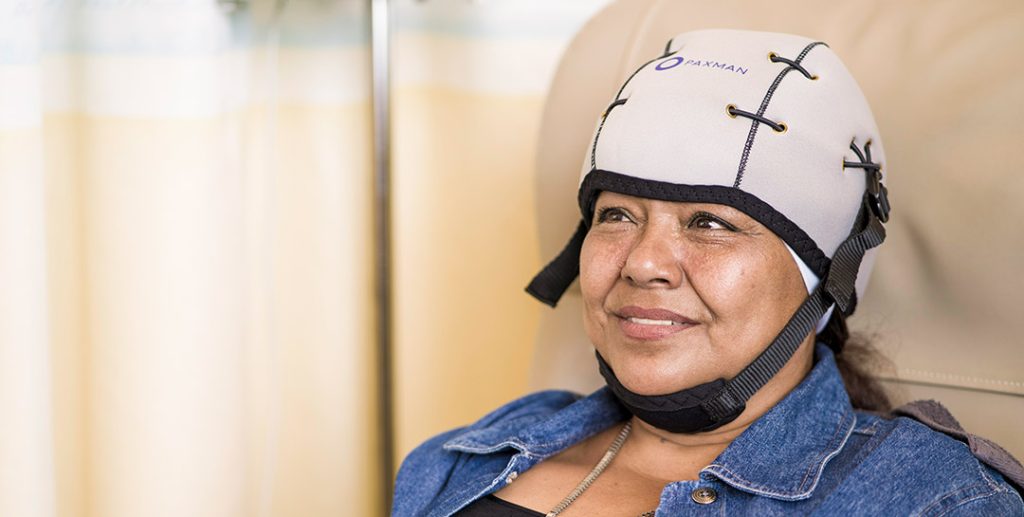
Advancements in cancer treatment are occurring all the time, but one consequence of chemotherapy stubbornly remains, alopecia or hair loss. This particular side effect can cause deep psychological and emotional repercussions on a patient’s quality of life. Chemotherapy-related hair loss can cause “anxiety, depression, lowered self-esteem, and an overall reduced sense of personal wellbeing” (1). Cancer patients who fear chemotherapy-induced hair loss have at times chosen less favorable treatment options, with worse outcomes, to avoid hair loss (1). When patients are choosing between the highest level of care and a side effect of treatment, it highlights an absolute need for a solution.
What are Scalp Cooling Caps?
Scalp cooling caps can be one solution for chemo-related hair loss. Scalp cooling, also called scalp hypothermia, involves the cooling of the scalp with cold caps before, during, or after a treatment of chemotherapy. New versions of scalp cooling caps are developed as a two-piece system. A computer controls the circulation of cooled liquid throughout the cap worn during treatment. A second neoprene cap covers the cooling cap to maintain the lower temperature. Two cooling cap systems that have received FDA approval are produced by Paxman and Dignicap. Cooling caps can be used to reduce hair loss in those with solid tumors, not those with leukemia or lymphoma.
How do Cooling Caps Reduce Chemo Induced Hair Loss?
Chemotherapy is a systemic treatment that attacks fast-growing cells in the body. Although cancer cells are fast-growing, hair cells are also fast-growing. Therefore, chemo patients can experience hair loss from their scalp, eyebrows, legs, and more. Hair loss from treatment affects all patients differently; some patients will lose all of their hair, while others may lose some or none of their hair (2).
Scalp cooling caps can help prevent or reduce the amount of treatment-related hair loss. This is because cooling caps tighten the scalp and reduce blood flow by constricting blood vessels. As a result of the restricted blood flow, it is theorized that less chemotherapy treatment can reach the hair follicles. When exposed to cold temperatures, hair follicles also enter a state of reduced activity which makes chemotherapy less likely to target that area (3).
How Effective are Cooling Caps at Preventing Hair Loss and What are the Side Effects?
Clinical studies measuring the effectiveness of cooling caps on hair loss prevention have been both limited and inconsistent. The SCALP Randomized Clinical Trial followed 182 women with stage 1 & 2 breast cancer who received taxane, anthracycline, or both forms of chemotherapy. The study concluded that 48 out of 98 women in the study retained 50% or more of their hair (4). A second study, using the Paxman system, found even more promising results in women who underwent taxane-based treatment for early-stage breast cancer. The study found that 68% of women retained 50% or more of their hair (5). And the majority of women, or 89%, were able to avoid severe hair loss (5).
The success of cooling caps may be dependent on a few variables: type of chemotherapy a patient is receiving, how well a person tolerates cold, how thick a person’s hair is, and how tightly fitted the cooling cap is. Some patients discontinue use due to adverse side effects including “headaches, neck and shoulder discomfort, chills, and pain in the scalp” (3). More clinical trials need to be completed to verify how well the treatment works and address any long-term questions (3).
Are Cooling Caps Right for You?
Many major cancer treatment centers offer some form of cooling cap therapy. When contemplating cooling cap therapy, you will want to weigh the potential benefits and side effects associated with cooling cap use. Many insurance companies do not cover scalp cooling. Although the cost of scalp cooling depends on how many treatments you need, the treatments may be priced up to $2,200 (2). Subsidies can be explored to help cover the cost of scalp cooling. To learn more about subsidies available, visit our resource guide. And finally, when you are deciding whether or not cooling cap therapy is right for you, you should consult with your doctor.
Sources
- Hesketh PJ, Batchelor D, Golant M, Lyman GH, Rhodes N, Yardley D. Chemotherapy-induced alopecia: psychosocial impact and therapeutic approaches. Support Care Cancer. 2004 Aug;12(8):543-9. doi: 10.1007/s00520-003-0562-5. Epub 2004 Jun 19. PMID: 15221580.
- “Managing Hair Loss with Scalp Cooling During Chemotherapy for Solid Tumors.” Memorial Sloan Kettering Cancer Center, 8 Jan. 2021, www.mskcc.org/cancer-care/patient-education/managing-hair-loss-scalp-cooling.
- “Cooling Caps (Scalp Hypothermia) to Reduce Hair Loss.” American Cancer Society, American Cancer Society, 10 Dec. 2020, www.cancer.org/treatment/treatments-and-side-effects/physical-side-effects/hair-loss/cold-caps.html#written_by.
- Nangia J, Wang T, Osborne C, et al. Effect of a Scalp Cooling Device on Alopecia in Women Undergoing Chemotherapy for Breast Cancer: The SCALP Randomized Clinical Trial. JAMA. 2017;317(6):596–605. doi:10.1001/jama.2016.20939.
- Gianotti E, Razzini G, Bini M, et al. Scalp Cooling in Daily Clinical Practice for Breast Cancer Patients Undergoing Curative Chemotherapy: A Multicenter Interventional Study. Asia Pac J Oncol Nurs. 2019;6(3):277-282. doi:10.4103/apjon.apjon_4_19.
